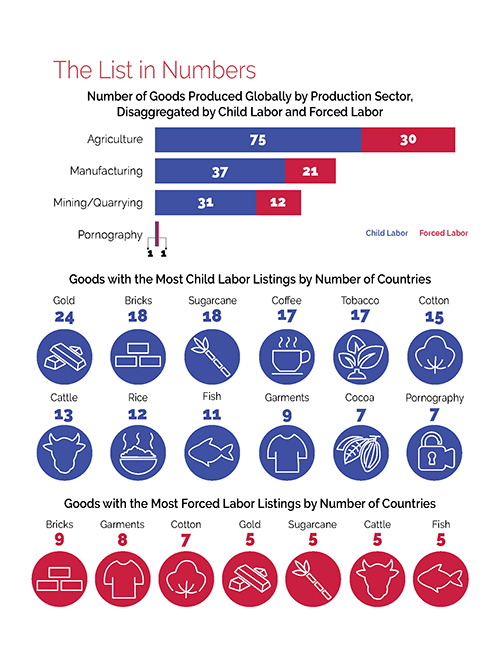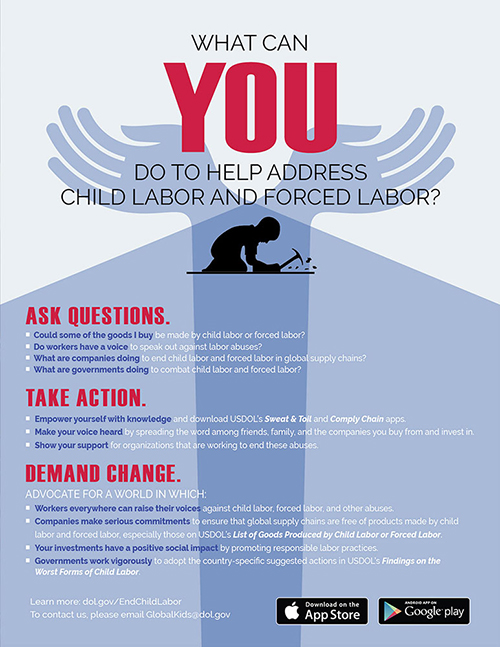List of Goods Produced by Child Labor or Forced Labor
The Bureau of International Labor Affairs (ILAB) maintains a list of goods and their source countries which it has reason to believe are produced by child labor or forced labor in violation of international standards, as required under the Trafficking Victims Protection Reauthorization Act (TVPRA) of 2005 and subsequent reauthorizations. The List of Goods Produced by Child Labor or Forced Labor comprises 159 goods from 78 countries and areas, as of September 28, 2022.
ILAB maintains the List primarily to raise public awareness about forced labor and child labor around the world and to promote efforts to combat them; it is not intended to be punitive, but rather to serve as a catalyst for more strategic and focused coordination and collaboration among those working to address these problems.
Publication of the List has resulted in new opportunities for ILAB to engage with foreign governments to combat forced labor and child labor. It is also a valuable resource for researchers, advocacy organizations and companies wishing to carry out risk assessments and engage in due diligence on labor rights in their supply chains.
The countries on the List span every region of the world. The most common agricultural goods listed are sugarcane, cotton, coffee, tobacco, cattle, rice, and fish. In the manufacturing sector, bricks, garments, textiles, footwear, carpets, and fireworks appear most frequently. In mined or quarried goods, gold, coal and diamonds are most common.
ILAB published the initial TVPRA List in 2009 and updated it annually through 2014, following a set of procedural guidelines that were the product of an intensive public consultation process. ILAB now updates and publishes the List every other year, pursuant to changes in the law.
Procedural Guidelines
On January 25, 2024, ILAB's Office of Child Labor, Forced Labor, and Human Trafficking published Procedural Guidelines for the development and maintenance of the List of Goods from countries produced by child labor or forced labor in violation of international standards.
| Country/Area | Good | Exploitation Type |
|---|---|---|
| Argentina | Child Labor | |
| Brazil | Child Labor | |
| Cambodia | Child Labor | |
| Indonesia | Child Labor | |
| Kenya | Child Labor | |
| Kyrgyz Republic | Child Labor | |
| Lebanon | Child Labor | |
| Malawi | There are reports that children in Malawi are forced to work producing tobacco. Tobacco estates are concentrated in the Mzimba, Kasungu, Mchinji and Mzimba districts. According to the most recently available data from the ILO and NGOs, over 70,000 children work on tobacco plantations, some of them under conditions of bonded labor. Families working on tobacco estates sometimes become bonded to their landlords, and their children are forced to work to repay their family debts. Landlords charge these tenant workers for costs such as rent, fertilizer, and seeds; these costs often exceed the profit earned from the tobacco harvest and result in debt for the worker and his or her family. Some children are also hired under deceptive terms of work and promised payment, and then are paid little, if at all, at the end of the season. Some children are forced to work long hours, including overtime, and are forced to perform dangerous tasks, such as carrying heavy loads and using pesticides. In addition, certain children work under threats and penalties including physical, verbal, and sexual abuse, and do not receive food or pay. |
Child Labor, Forced Labor |
| Mexico | Child Labor | |
| Mozambique | Child Labor |
your hand? Download ILAB's Sweat & Toil App today!
Are you a company looking to fight child labor and forced labor in supply
chains?





